|
|
|
|
Coordinate geometry
(or Analytic geometry) in three-dimensional space
|
|
|
|
::
Equations of a plane in a coordinate space
|
|
The equation of a
plane in
a
3D coordinate system
|
|
A plane in space is defined by three points (which don’t all lie on the same line) or by a point and a
normal
vector to the plane. |
|
Then, the scalar product of the vector
P1P
= r -
r1, drawn from the
given point P1(x1,
y1, z1) of the plane to any point
P(x,
y, z)
of the plane, and the normal vector N
= Ai + Bj
+ Ck, is zero, that is |
|
 |
which is called the vector equation of a
plane. |
|
|
Or,
|
 |
|
|
| Therefore, |
| (x
-
x1)
· A
+ (y -
y1)
· B
+ (z -
z1)
· C
= 0 |
| giving
A
· x
+ B · y
+ C · z
+ D = 0 |
|
where, D
=
-
(Ax1+
By1+
Cz1) |
|
the general equation of a plane in 3D
space. |
|
If plane passes through the origin
O
of a coordinate system then its coordinates,
x =
0, y
= 0, and
z
= 0 plugged into the equation of the plane, give |
| A
· 0
+ B · 0
+ C · 0
+ D = 0 => D = 0. |
| Thus, the condition that plane passes through the
origin is D
= 0. |
|
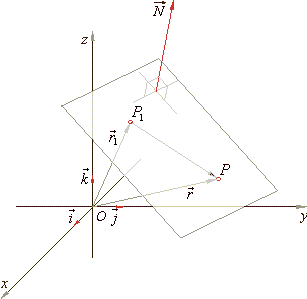 |
|
|
|
The Hessian normal form of the
equation of a plane
|
| Position of a plane in space can also be defined by the length of the normal, drawn from the origin to the plane
and by angles,
a, b and
g, that the normal forms with the
coordinate axes. |
| If
N°
is the unit vector of the normal then its components are,
cosa,
cosb
and
cosg.
|
| Then the projection of the position vector
r, of any point
P(x,
y, z) of the plane, onto the normal has the length
p. |
| Since the projection is determined by expression |
 |
| that is,
r
· N°
= p or
written in the coordinates |
| x
· cosa
+ y · cosb
+ z · cosg
-
p = 0 |
| represents the
equation of a plane in the Hessian
normal
form. |
|
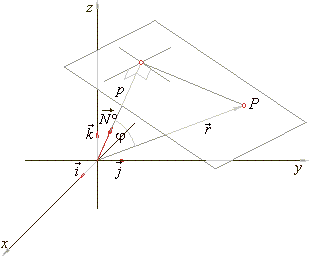 |
|
|
|
The intercept form of the equation of a
plane
|
|
If,
l,
m
and n
are the intercepts of
x,
y
and z
axes and a plane respectively, then projections of these segments in
direction of the normal drawn from the origin to the
plane are all equal to the length of the normal, that is
|
|
|
|
|
The distance between a point and a
plane - plane given in Hessian normal form
|
| Distance from a point
A0(x0,
y0, z0)
to a plane is taken to be positive if the given point is on the one side |
|
while the origin is on the other side regarding to the plane, as is in
the right figure. |
|
Through the point
A
lay a plane parallel to the given plane. The length of a normal segment from the origin to the plane through
A,
written in the normal form, is p +
d. |
| As the point A
lies in that plane its coordinates must satisfy the equation |
| x0
· cosa
+ y0 · cosb
+ z0 · cosg
= p +
d. |
| Thus, the
distance of the point to the given
plane is
|
| d
= x0
· cosa
+ y0 · cosb
+ z0 · cosg -
p
|
|
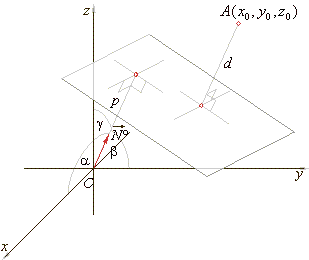 |
|
|
|
|
Comparison of general form and the
Hessian normal form of equations of a plane
|
| Coefficients,
A,
B
and C
of coordinates x,
y
and z, of the general form of equation
of a plane |
| Ax
+ By
+ Cz
+ D = 0 |
| are the components of the normal vector
N
= Ai + Bj
+ Ck, while in the Hessian’s equation |
| x
· cosa
+ y · cosb
+ z · cosg
-
p
= 0, |
| on that place, there are components (the direction cosines) of the unit vector
N°
of the same vector. |
 |
| Thus, to convert from general form to the Hessian normal form, divide the general form of equation by |
 |
taking the sign of the square root opposite to the sign of
D, where
D
is not 0 |
|
 |
|
|
The distance of a point to a plane -
plane given in general form
|
| Let
replace in the Hessian formula for the distance d
= x0
· cosa
+ y0 · cosb
+ z0 · cosg -
p, |
| the direction
cosines and the length of the normal p, by coefficients of the general form,
to obtain |
 |
| the formula for the
distance of a point to a plane given in the general
form. |
|
|
Angle (dihedral angle) between two
planes
|
| The angle subtended by normals drawn from the origin to the first and second plane, that is, the angle which
form
the normal vectors of the given planes is |
 |
| the
angle between two planes. If planes are parallel normal vectors are collinear that is, |
| N1
= lN2
<=> j
= 0°, |
| and if planes are orthogonal, then their normal vectors are orthogonal too, so their scalar product is zero, |
| N1 · N2
= 0 <=> j
= 90°. |
|
|
|
Example:
Find the equation of
the plane through three points, A(-1,
1, 4), B(2,
4, 3)
and C(-3,
4, 1).
|
|
Solution: Equation of a plane
|
| Ax
+ By
+ Cz
+ D = 0 |
| is determined by
the components (the
direction cosines)
of the normal vector N
= Ai + Bj
+ Ck and
the coordinates of any point of the plane. |
| The normal vector is perpendicular to the plane determined by given
points, and as the vector |
| AB
= rB -
rA
= (2i + 4j + 3k)
-
(-i
+ j + 4k)
|
| rB
-
rA
= 3i + 3j -
k,
and the vector
|
|
AC =
rC -
rA
= -2i
+ 3j -
3k
|
| then,
|
|
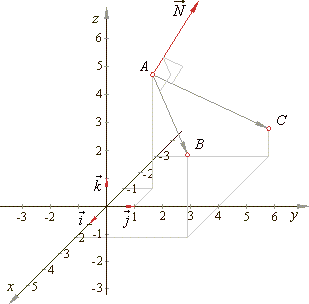 |
|
 |
|
By plugging the coordinates, of any given point, into equation
of the plane determines the value of the coefficient D.
Thus, plugging |
| A(-1,
1, 4) into -
6x
+ 11y + 15z + D = 0
gives -
6
· (-1)
+ 11
· 1
+ 15
· 1
+ D = 0, D = -77. |
|
Therefore,
-
6x + 11y + 15z -
77 = 0 is the equation of the plane
the given points lie on. |
| The coordinate of the remaining two points
B
and C
must also satisfy the obtained equation, prove. |
|
|
Example:
Segments that a plane cuts on the axes, x
and y, are
l = -1 and
m = -2
respectively, find the standard or general equation of the plane if it passes through the point
A(3, 4, 6).
|
|
Solution: As the given point A(3, 4,
6) and the segments, l =
-1 and
m = -2
must satisfy the intercept form of the equation of plane,
then |
 |
|
|
Example:
Find the angle between planes,
P1
::
2x -
y + 4z -
3 = 0 and
P2
::
-x -
3y + 5z + 6 = 0.
|
|
Solution: Thus, |
| N1 =
2i
-
j + 4k and
N2
=
-i
-
3j + 5k,
then |
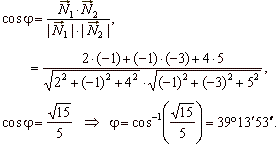 |
|
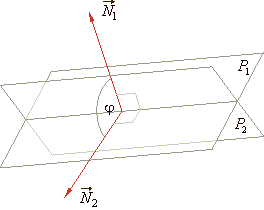 |
|
|
|
|
|
|
|
|
|
|
|
|
|
|
|
|
|
|
|
|
|
|
|
|
|
|
|
|
Contents C
|
|
|
|
|

|
|
|
|
|
|
Copyright
© 2004 - 2020, Nabla Ltd. All rights reserved.
|
|
|